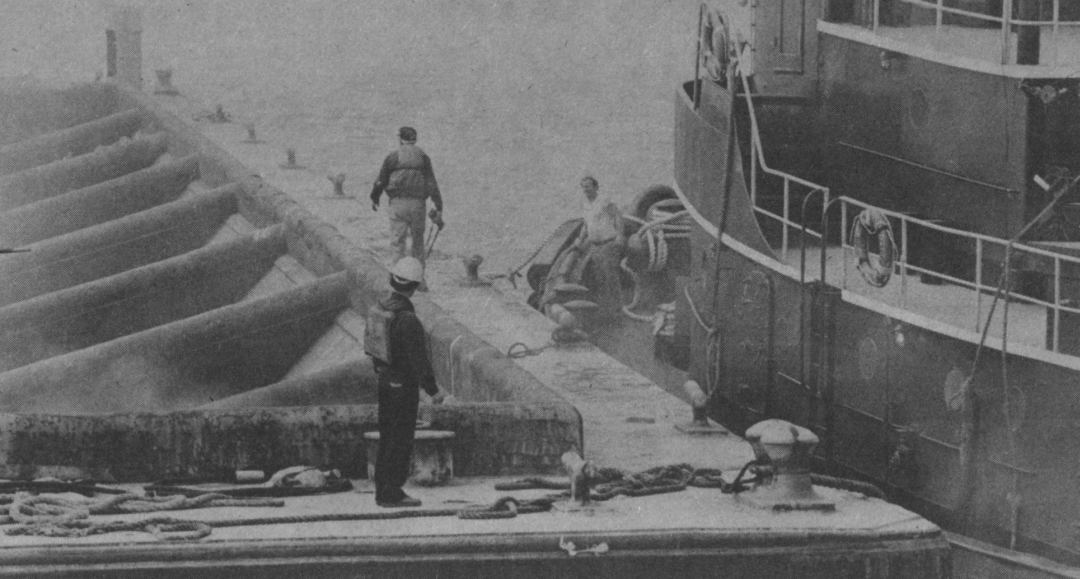The coastal reef, built by MSRC researchers by dropping blocks of coal wastes In September 1980 (above) still provides a habitat for ocean life, non-state funds were used to initiate this Innovative environmental project, as well as other projects conducted on board the center’s research vessel, Onrust.
From Private dollars help MSRC help ocean life on Stony Brook People, 1984
Editor’s Note: non-state dollars are as necessary, if not more crucial, to the funding of Stony Brook as state dollars, according to University officials. The flexibility of these funds allows for programs such as the Marine Sciences Research Center to flourish. Director Jerry Schubel described recently Just how the center utilizes its valuable non-state resources.
The once-dismal outlook of the coastal environment of Long Island is looking a little brighter these days, thanks, in part, to projects funded by non-state sources. The Marine Sciences Research Center’s (MSRC) budget totalled $907,390 in state funds last year. In addition to that amount $59,427 was raised from private individuals and the center was awarded $2,229,711 in research funding.
What exactly did the center do with its non-state money?
The MSRC utilized one of its research grants to provide the solution to an environmental problem. The Coal Waste Artificial Reef Project (CWARP) is now in its final stages. It began in 1978 with an initial award of $99,996 and an idea: To chemically stabilize wastes produced by coal-fired power generating plants, shape the result into blocks and create an artificial fishing reef that would not release contaminants to the surrounding waters.
Five years and $2,553 in funding later, the project appears successful. After a number of efforts to get the proper “mix” of coal wastes, and laboratory tests of the structural and chemical stability of the blocks, 500 tons of blocks were dropped 2.5 miles off Long Island’s south shore in September 1980. Careful monitoring of the reef over the past several years has revealed no adverse environmental effects and the blocks continue to attract fish and crustaceans.
Along the way the reefs expenditures included:
- Personnel. Though only four project members remain, over the years CWARP has employed 30 people. The project involved collaborations with private industry, and the University’s Institute for Energy Research and Department of Materials Science.
- Equipment and supplies. $384,000 covered the costs of everything from a $40,000 atomic absorption spectrophotometer, used to analyze trace quantitites of elements like arsenic and sodium to small screwdrivers costing less than $1 each. At 15 feet long by 5 feet high, the spectrophotometer required its own room. Each day spent on the MSRC’s 55-foot research vessel ONRUST cost CWARP $1,000. About four days a month were spent at sea during much of the project.
- Travel. $42,000 made possible trips to Alpena, MI, a town so small that travel agents at first had difficulty locating an airfield anywhere near it There the researchers worked with the Besser Company to develop methods of forming the coal waste blocks. Later they traveled throughout the Midwest, to obtain raw materials for the blocks from coal-burning power plants.
- Publishing. $2,000 has financed the 50 CWARP publications that either are in press or have been published in scientific journals. Other successful ventures at the center include efforts initiated with support from private individuals. Several years ago, the MSRC sought and received private funds to begin a new research group on beach and nearshore processes, to understand the forces that build up and erode the shoreline. Today the group, the only one of its kind in New York State, is supported entirely by grants, contracts and state funds.
“I would not use fundraising to solve a problem that results from underfunding by the state,” explained MSRC Director Jerry Schubel. “I would use it to exploit a new opportunity or start a new program.”
 The approach has meant opportunities for many graduate students. For seven years the Jessie Smith Moyes Foundation has contributed full support, more than $10,000 per year per student for two or three students a year. Three students have received the annual $1,000 Montauk Marine Basin Scholarship, donated to support research on problems affecting Long Island.
The approach has meant opportunities for many graduate students. For seven years the Jessie Smith Moyes Foundation has contributed full support, more than $10,000 per year per student for two or three students a year. Three students have received the annual $1,000 Montauk Marine Basin Scholarship, donated to support research on problems affecting Long Island.
And private individuals contributed $100 a year to become MSRC Associates; corporate memberships are $2,500. Their contributions have been used to send students to scientific meetings, support graduate research and fund a “Distinguished Teaching Award” presented annually to a faculty member selected by the students.
Other efforts made possible through private funds are the Distinguished Visiting Scholar and Coastal Marine Scholar programs. The aim of both is to bring high quality oceanographers from other institutions to the center, to allow collaboration between them and center personnel.
One of Prof. Schubel’s goals is to raise an additional $60,000 to enable the Coastal Marine and Distinguished Visiting Scholar programs to become self-sustaining (supported completely by private, non-state funds) in another year. “It is critical to use funds from private sources for leverage,” he stressed. “Telling people you have a problem doesn’t excite them. You must tell them what new, exciting or different things you would do with the money.”





You must be logged in to post a comment.